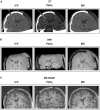An overview of clinical cerebral microdialysis in acute brain injury
- PMID: 36895905
- PMCID: PMC9989027
- DOI: 10.3389/fneur.2023.1085540
An overview of clinical cerebral microdialysis in acute brain injury
Abstract
Cerebral microdialysis may be used in patients with severe brain injury to monitor their cerebral physiology. In this article we provide a concise synopsis with illustrations and original images of catheter types, their structure, and how they function. Where and how catheters are inserted, their identification on imaging modalities (CT and MRI), together with the roles of glucose, lactate/pyruvate ratio, glutamate, glycerol and urea are summarized in acute brain injury. The research applications of microdialysis including pharmacokinetic studies, retromicrodialysis, and its use as a biomarker for efficacy of potential therapies are outlined. Finally, we explore limitations and pitfalls of the technique, as well as potential improvements and future work that is needed to progress and expand the use of this technology.
Keywords: brain injury; cerebral microdialysis; cerebral physiology; neurocritical care; subarachnoid hemorrhage (SAH); traumatic brain injury (TBI).
Copyright © 2023 Stovell, Helmy, Thelin, Jalloh, Hutchinson and Carpenter.
Conflict of interest statement
PH was a director of Technicam (Newton Abbot, UK), the manufacturer of the cranial access device used in Cambridge. The remaining authors declare that the research was conducted in the absence of any commercial or financial relationships that could be construed as a potential conflict of interest.
Figures


References
Publication types
Grants and funding
LinkOut - more resources
Full Text Sources

